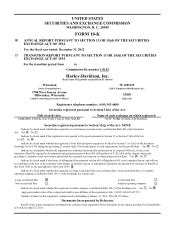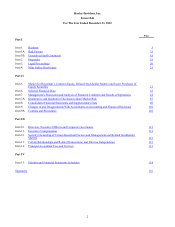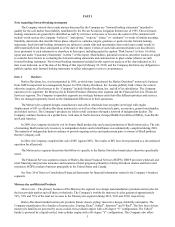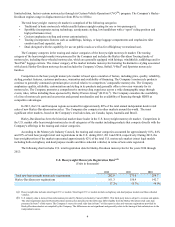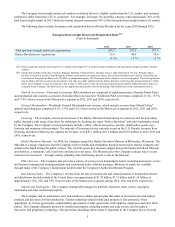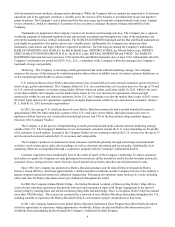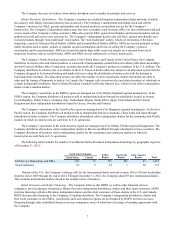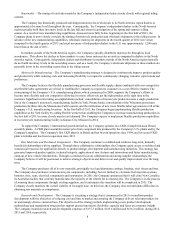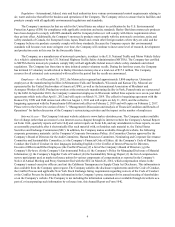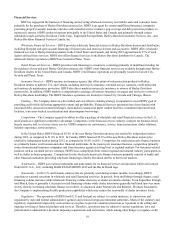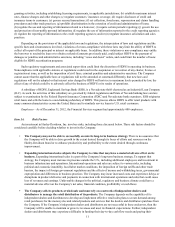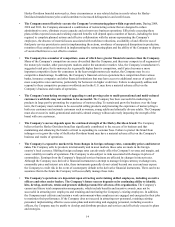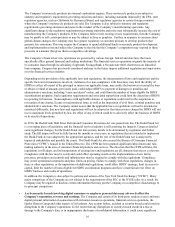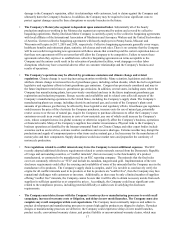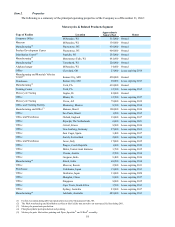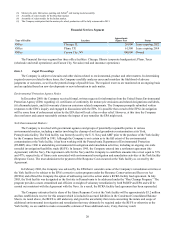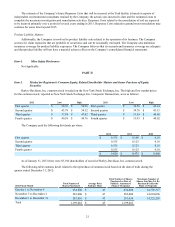Harley Davidson 2012 Annual Report Download - page 11
Download and view the complete annual report
Please find page 11 of the 2012 Harley Davidson annual report below. You can navigate through the pages in the report by either clicking on the pages listed below, or by using the keyword search tool below to find specific information within the annual report.11
granting activities, including establishing licensing requirements, in applicable jurisdictions; (b) establish maximum interest
rates, finance charges and other charges; (c) regulate customers’ insurance coverage; (d) require disclosure of credit and
insurance terms to customers; (e) govern secured transactions; (f) set collection, foreclosure, repossession and claims handling
procedures and other trade practices; (g) prohibit discrimination in the extension of credit and administration of loans;
(h) regulate the use and reporting of information related to a borrower; (i) require certain periodic reporting; (j) govern the use
and protection of non-public personal information; (k) regulate the use of information reported to the credit reporting agencies;
(l) regulate the reporting of information to the credit reporting agencies; and/or (m) regulate insurance solicitation and sales
practices.
Depending on the provisions of the applicable laws and regulations, the interpretation of laws and regulations and the
specific facts and circumstances involved, violations of or non-compliance with these laws may limit the ability of HDFS to
collect all or part of the principal or interest on applicable loans. In addition, these violations or non-compliance may entitle
the borrower to rescind the loan or to obtain a refund of amounts previously paid, could subject HDFS to the payment of
damages or penalties and administrative sanctions, including “cease and desist” orders, and could limit the number of loans
eligible for HDFS securitization programs.
Such regulatory requirements and associated supervision could limit the discretion of HDFS in operating its business.
Noncompliance with applicable statutes or regulations could result in the suspension or revocation of any charter, license or
registration at issue, as well as the imposition of civil fines, criminal penalties and administrative sanctions. The Company
cannot assure that the applicable laws or regulations will not be amended or construed differently, that new laws and
regulations will not be adopted or that interest rates charged by HDFS will not rise to maximum levels permitted by law, the
effect of any of which could be to adversely affect the business of HDFS or its results of operations.
A subsidiary of HDFS, Eaglemark Savings Bank (ESB), is a Nevada state thrift chartered as an Industrial Loan Company
(ILC). As such, the activities of this subsidiary are governed by federal regulations and State of Nevada banking laws and are
subject to examination by the Federal Deposit Insurance Corporation (FDIC) and Nevada state bank examiners. ESB originates
retail loans and sells the loans to a non-banking subsidiary of HDFS. This process allows HDFS to offer retail products with
many common characteristics across the United States and to similarly service loans to U.S. retail customers.
Employees – As of December 31, 2012, the Financial Services segment had approximately 600 employees.
Item 1A. Risk Factors
An investment in Harley-Davidson, Inc. involves risks, including those discussed below. These risk factors should be
considered carefully before deciding whether to invest in the Company.
• The Company may not be able to successfully execute its long-term business strategy. There is no assurance that
the Company will be able to drive growth to the extent desired through its focus of efforts and resources on the
Harley-Davidson brand or to enhance productivity and profitability to the extent desired through continuous
improvement.
• Expanding international sales subjects the Company to risks that may have a material adverse effect on its
business. Expanding international sales is a part of the Company’s long-term business strategy. To support that
strategy, the Company must increase its presence outside the U.S., including additional employees and investment in
business infrastructure and operations. International operations and sales are subject to various risks, including
political and economic instability, local labor market conditions, the imposition of foreign tariffs and other trade
barriers, the impact of foreign government regulations and the effects of income and withholding taxes, governmental
expropriation and differences in business practices. The Company may incur increased costs and experience delays or
disruptions in product deliveries and payments in connection with international operations and sales that could cause
loss of revenues and earnings. Unfavorable changes in the political, regulatory and business climate could have a
material adverse effect on the Company’s net sales, financial condition, profitability or cash flows.
• The Company sells its products at wholesale and must rely on a network of independent dealers and
distributors to manage the retail distribution of its products. The Company depends on the capability of its
independent dealers and distributors to develop and implement effective retail sales plans to create demand among
retail purchasers for the motorcycles and related products and services that the dealers and distributors purchase from
the Company. If the Company’s independent dealers and distributors are not successful in these endeavors, then the
Company will be unable to maintain or grow its revenues and meet its financial expectations. Further, independent
dealers and distributors may experience difficulty in funding their day-to-day cash flow needs and paying their

